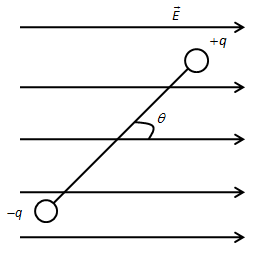
An electric dipole of dipole moment \[\vec p\] is placed in an uniform electric field \[\vec E\] has minimum potential energy when the angle between \[\vec p\] and \[\vec E\] is
A. \[\dfrac{\pi }{2}\]
B. Zero
C. \[\pi \]
D. \[\dfrac{{3\pi }}{2}\]
Answer
456.2k+ views
Hint: Refer to the formula for the potential energy of the electric dipole. The negative sign of the potential energy of the dipole implies the minimum potential energy.
Formula used:
\[U\left( \theta \right) = - pE\cos \theta \]
Here, \[\theta \] is the angle between the dipole moment \[\vec p\] and the electric field \[\vec E\].
Complete step by step answer:
An electric dipole is a system of two opposite charges \[ + q\] and \[ - q\] separated by the distance \[2a\] placed in a uniform electric field \[\vec E\] as shown in the figure below.

The potential energy of the dipole is given by the equation,
\[U\left( \theta \right) = - pE\cos \theta \]
Here, \[\theta \] is the angle between the dipole moment \[\vec p\] and the electric field \[\vec E\].
The potential energy of the dipole is minimum, that is \[ - pE\] when \[\cos \theta = 1\]. Therefore, we can substitute \[0^\circ \] for \[\theta \].
Thus,
\[U\left( \theta \right) = - pE\cos \left( {0^\circ } \right)\]
\[ \Rightarrow U\left( \theta \right) = - pE\]
The potential energy of the dipole is zero, when the angle between dipole moment \[\vec p\] and electric field \[\vec E\] is \[\dfrac{\pi }{2}\].
Also, the potential energy of the dipole moment is maximum, that is \[ + pE\] when the angle between dipole moment \[\vec p\] and electric field \[\vec E\], is \[\pi \].
So, the correct answer is “Option C”.
Note:
The minimum potential energy of the dipole does not mean the potential energy to be zero. The potential energy of the dipole is minimum when the dipole is parallel to the external electric field. Also, it is the maximum when the dipole is anti-parallel to the external electric field.
Formula used:
\[U\left( \theta \right) = - pE\cos \theta \]
Here, \[\theta \] is the angle between the dipole moment \[\vec p\] and the electric field \[\vec E\].
Complete step by step answer:
An electric dipole is a system of two opposite charges \[ + q\] and \[ - q\] separated by the distance \[2a\] placed in a uniform electric field \[\vec E\] as shown in the figure below.

The potential energy of the dipole is given by the equation,
\[U\left( \theta \right) = - pE\cos \theta \]
Here, \[\theta \] is the angle between the dipole moment \[\vec p\] and the electric field \[\vec E\].
The potential energy of the dipole is minimum, that is \[ - pE\] when \[\cos \theta = 1\]. Therefore, we can substitute \[0^\circ \] for \[\theta \].
Thus,
\[U\left( \theta \right) = - pE\cos \left( {0^\circ } \right)\]
\[ \Rightarrow U\left( \theta \right) = - pE\]
The potential energy of the dipole is zero, when the angle between dipole moment \[\vec p\] and electric field \[\vec E\] is \[\dfrac{\pi }{2}\].
Also, the potential energy of the dipole moment is maximum, that is \[ + pE\] when the angle between dipole moment \[\vec p\] and electric field \[\vec E\], is \[\pi \].
So, the correct answer is “Option C”.
Note:
The minimum potential energy of the dipole does not mean the potential energy to be zero. The potential energy of the dipole is minimum when the dipole is parallel to the external electric field. Also, it is the maximum when the dipole is anti-parallel to the external electric field.
Recently Updated Pages
Master Class 12 Biology: Engaging Questions & Answers for Success

Master Class 12 Physics: Engaging Questions & Answers for Success

Master Class 12 Economics: Engaging Questions & Answers for Success

Master Class 12 Maths: Engaging Questions & Answers for Success

Master Class 11 Economics: Engaging Questions & Answers for Success

Master Class 11 Accountancy: Engaging Questions & Answers for Success

Trending doubts
Which are the Top 10 Largest Countries of the World?

Differentiate between homogeneous and heterogeneous class 12 chemistry CBSE

Why is the cell called the structural and functional class 12 biology CBSE

State and explain Coulombs law in electrostatics class 12 physics CBSE

a Tabulate the differences in the characteristics of class 12 chemistry CBSE

Who discovered the cell and how class 12 biology CBSE




